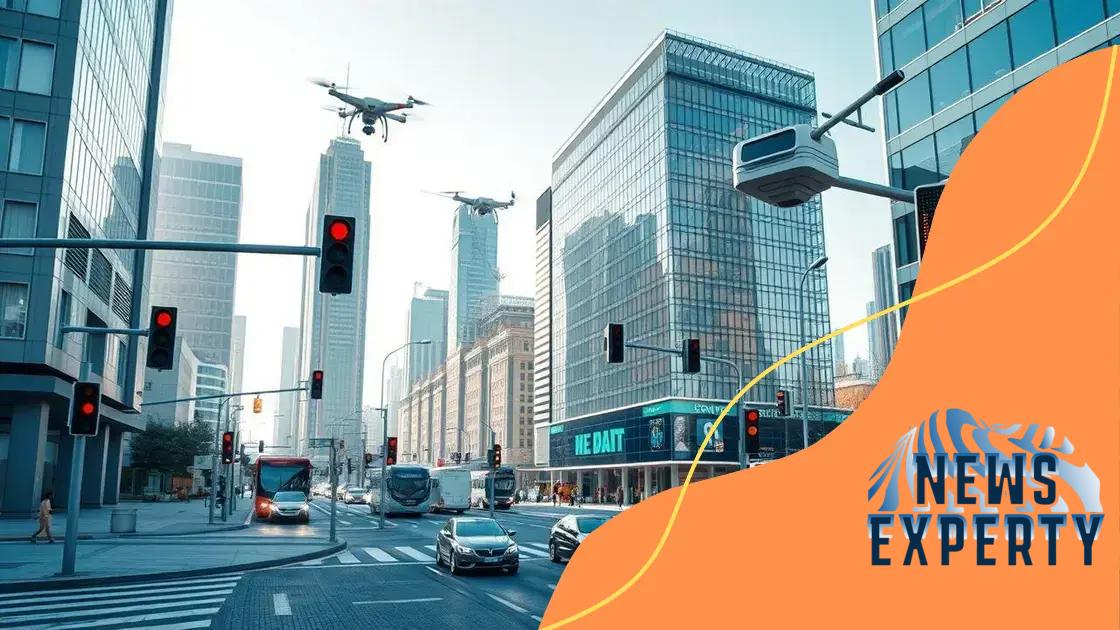How 5G is changing the landscape of smart cities

5G is transforming the landscape of smart cities by enhancing connectivity, enabling smart infrastructure, improving public services, and promoting sustainability while addressing challenges like infrastructure upgrades and equitable access.
How 5G is changing the landscape of smart cities is a question that many urban planners and tech enthusiasts are asking. This new technology not only promises faster connections but also the potential to revolutionize how cities operate. Curious about what this means for your community? Let’s dive in.
The basics of 5G technology
Understanding the basics of 5G technology is crucial to grasp its impact on smart cities. This generation of mobile technology promises to deliver faster speeds, lower latency, and greater connectivity.
What is 5G?
5G is the fifth generation of wireless technology, designed to enhance data transfer rates significantly. Unlike previous generations, 5G operates on multiple frequency bands, making it adaptable and efficient.
Key Features of 5G
This technology comes with several advantages. Some of the most notable benefits include:
- High Speed: Offers download speeds that can reach up to 20 Gbps.
- Low Latency: Reduces the time it takes for data to travel between devices to just a few milliseconds.
- Increased Capacity: Supports a large number of devices simultaneously without degrading performance.
- Enhanced Connectivity: Provides a seamless connection even in dense urban environments.
The attributes of 5G technology are expected to facilitate improvements in infrastructure, transportation, and public services. For example, cities can implement smarter traffic management systems, which will minimize congestion and pollution. Additionally, 5G enables the development of Internet of Things (IoT) applications, allowing a network of interconnected devices for better resource management.
As we delve deeper into this topic, it’s important to note how 5G is altering communication. With its high-speed connectivity, real-time data sharing becomes possible between vehicles, sensors, and centralized systems. This interconnectivity can lead to enhanced public safety and efficiency in city operations.
This foundation of understanding will pave the way for the challenges and innovations that lay ahead in the journey toward fully realized smart cities.
Key benefits of 5G for smart cities
The key benefits of 5G for smart cities are transforming how urban environments function. With this technology, cities can enhance their operations and improve the quality of life for residents.
Improved Connectivity
5G technology allows for easier communication between devices, making it possible for smart devices to work together seamlessly. This interconnectedness is critical for efficient city management.
Smart Infrastructure
As cities implement 5G, they can develop smarter infrastructure. This includes advanced traffic systems that can adjust in real-time based on congestion levels. Not only does this reduce travel times, but it also minimizes environmental impacts.
- Real-time Data Access: City managers can access vital information instantly to make informed decisions.
- Enhanced Public Safety: Emergency services can respond more quickly and effectively with better communication tools.
- Energy Efficiency: City services can optimize resource usage, leading to lower energy consumption and costs.
- Citizen Engagement: Residents gain better access to information and services, fostering a sense of community.
The introduction of 5G also enhances public transportation systems. Buses and trains can communicate their locations and schedules in real-time, allowing riders to plan their trips more efficiently. This leads to increased usage of public transit and a reduction in individual car usage.
Moreover, the capability of 5G to support numerous devices simultaneously plays a vital role in developing smart homes and offices. Devices like smart thermostats, security systems, and appliances can communicate with each other, creating more efficient living and working environments.
Real-world examples of 5G implementations

Exploring real-world examples of 5G implementations showcases how cities are integrating this technology into their infrastructure to enhance urban living. Various pioneering cities are stepping up to embrace 5G, leading to significant advancements.
Smart Traffic Management
In cities like Los Angeles, 5G technology is used for smart traffic management systems. These systems analyze real-time data from sensors and cameras to adjust traffic signals accordingly. This approach reduces congestion and improves travel times for drivers.
Enhanced Public Safety
In Kuala Lumpur, Malaysia, 5G is helping enhance public safety through the use of connected surveillance systems. With high-speed connectivity, emergency services can access visual data in real-time, making it easier to respond to incidents swiftly.
- Connected Emergency Services: Ambulances and police vehicles can communicate vital information instantly.
- Smart Lighting Systems: Streetlights adapt to their surroundings, saving energy and improving safety.
- Integrated Environment Monitoring: Sensors can detect air quality and noise levels, improving overall public health.
Another notable example is in Barcelona, Spain, where 5G is being used to support smart tourism initiatives. Visitors can enjoy augmented reality experiences that enhance their exploration of cultural sites, giving real-time information and recommendations.
In healthcare, cities like Chicago are using 5G to support telemedicine. With improved connectivity, doctors can consult with patients remotely, making healthcare more accessible. This implementation reduces the need for patients to travel for appointments and ensures timely medical advice.
These examples highlight how 5G is transforming urban environments. Through increased connectivity and smarter solutions, cities are becoming more efficient and sustainable, greatly improving residents’ quality of life.
Challenges to overcome with 5G deployment
Deploying 5G technology presents various challenges that cities and service providers need to address. Understanding these obstacles is essential for ensuring successful integration into urban environments.
Infrastructure Requirements
One significant challenge is the need for extensive infrastructure upgrades. Unlike previous generations, 5G relies on a network of small cell towers placed closer together to provide the needed coverage. This means cities must invest in new equipment and installation, which can be costly.
Regulatory Hurdles
Another challenge involves navigating complex regulations and securing permits for new installations. City planners and telecom companies must work together to ensure that the deployment meets local rules and zoning laws. Communities often have concerns about the placement of antennas and their impact on neighborhoods.
- Community Engagement: Gaining public support is crucial, as residents may have fears about health effects from increased radio waves.
- Environmental Considerations: Urban redesigns must account for landscaping and visual aesthetics.
- Funding Challenges: Cities need to find funds for infrastructure upgrades, often relying on partnerships with private companies.
Additionally, the rollout of 5G technology raises cybersecurity concerns. With increased connectivity comes the increased risk of cyberattacks. Protecting sensitive data transmitted over networks is essential for maintaining public trust.
Another hurdle is ensuring equitable access to 5G. Some areas, particularly rural regions, may lag in connectivity due to lack of infrastructure. Striving for equal access across various neighborhoods is vital for fostering smart city development.
These challenges highlight that while 5G could revolutionize urban living, careful planning, investment, and community involvement are essential to navigate potential pitfalls in deployment.
The future of urban living with 5G
The future of urban living with 5G holds exciting possibilities that will reshape how we interact with our cities. As 5G technology continues to expand, our urban environments are poised to become more efficient, connected, and sustainable.
Smart Homes and Buildings
One major aspect of this future involves smart homes and buildings. With 5G, everyday devices can be interconnected, allowing homeowners to control everything from lighting to security systems remotely. This level of automation not only enhances convenience but also promotes energy efficiency.
Enhanced Public Services
Innovative public services are also on the horizon. Cities will utilize 5G to improve public transportation systems through real-time data sharing. Buses and trains can communicate their locations and schedules to reduce wait times and overcrowding. This leads to a more efficient commuting experience for residents.
- Real-time Alerts: Commuters will receive instant notifications about delays or changes in service.
- Adaptive Traffic Control: Traffic signals will adjust based on actual traffic conditions, minimizing congestion.
- Integrated Waste Management: Sensors in waste bins can signal when they need to be emptied, optimizing collection routes.
The implementation of smart grids powered by 5G is also a vital part of the future landscape. These grids will help monitor and manage energy usage efficiently, reducing waste and lowering costs for residents. As cities embrace renewable energy sources, 5G will enable better integration of these resources into the grid.
Moreover, health services are expected to become more accessible through telemedicine options supported by 5G. Patients can consult with healthcare providers from their homes, allowing for timely and convenient care. This shift could be especially beneficial for those living in remote areas.
Overall, the potential of 5G technology is transforming urban living. As cities adapt to these advancements, residents will experience a seamless blend of connectivity and convenience, leading to a more sustainable and enjoyable lifestyle.
FAQ – Frequently Asked Questions about 5G and Smart Cities
How does 5G technology enhance urban living?
5G technology provides faster internet speeds and improved connectivity, enabling smart city infrastructure and optimized public services.
What are some real-world applications of 5G in cities?
Cities use 5G for smart traffic management, connected emergency services, and improved healthcare access through telemedicine.
What challenges do cities face when deploying 5G?
Challenges include infrastructure upgrades, regulatory hurdles, cybersecurity concerns, and ensuring equitable access across all communities.
What is the future potential of 5G in urban environments?
The future includes smarter homes, enhanced public transport, sustainable energy solutions, and more efficient public services, all connected by 5G.

